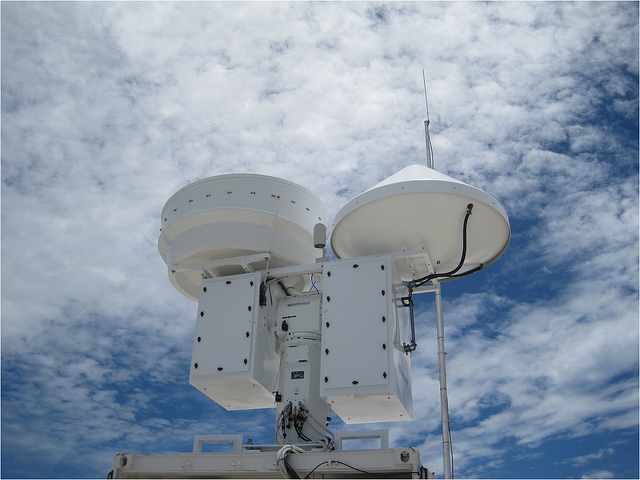ARM Considers Future of Its Scanning Cloud Radars
Published: 24 February 2022
Users are invited to share their feedback during upcoming radar listening sessions

The Atmospheric Radiation Measurement (ARM) user facility deploys an extensive suite of complex instrumentation to tackle a broad range of science objectives. To allow for the flexibility to deploy new capabilities, ARM must sometimes retire capabilities that are less impactful. A recommendation from ARM’s most recent Triennial Review was to develop a process for reviewing ARM’s capabilities and to apply this process each year.
In 2021, ARM was charged with evaluating its suite of scanning ARM cloud radars (SACRs) to determine the viability of the SACR systems. ARM operates dual-frequency Ka/W-band SACRs at its three fixed-location atmospheric observatories and either Ka/W- or Ka/X-band systems with ARM Mobile Facilities (AMFs) upon request.
The SACRs are among the most complex ARM instruments and have had several operational challenges in the past decade, but ARM has operated the radars with more success in recent years.
There are two generations of SACRs. The first-generation SACRs were initially deployed to the Southern Great Plains (SGP) and North Slope of Alaska (NSA) observatories and the Tropical Western Pacific (TWP) Manus and Darwin sites in 2011, then later with the first and second ARM Mobile Facilities (AMF1 and AMF2). ARM initially deployed second-generation SACRs to the third ARM Mobile Facility (AMF3) site in Oliktok Point, Alaska, in 2015 and the Eastern North Atlantic (ENA) observatory in 2016.
The primary science objectives for the SACRs are cloud life cycle studies, cloud microphysics, mapping, and evolution. Both generations of SACRs have dual-polarization capability, but second-generation SACRs (called SACR2s) measure full dual polarization (both transmitting and receiving). SACR2s also allow for the characterization of nonspherical hydrometeors, including ice and snow. The SACR2 at Oliktok recently moved to the NSA site at Utqiaġvik to replace an older system.
Key Recommendations for ARM
In fall 2021, a team of four ARM infrastructure staff members—representing engineering, operations, radar data calibration and processing, and value-added products—completed a review of the full suite of SACRs. The review team evaluated the instrument stability, cost, data usage, and scientific impact of each SACR using a weighted scoring system for each criterion. The goal of this review was to help develop an optimal plan for deploying and providing useful SACR data products to enable high-impact science in diverse climate regimes.
Analysis of ARM data from the past decade makes it clear that the SACRs can successfully operate with significant dedicated effort. It is also clear that they cannot operate for extended periods of time without recurring effort.
These challenges, combined with a better understanding of the instruments’ performance characteristics, have led to a set of recommendations for the SACRs currently in the field. The main recommendations of the SACR review are as follows:
- Discontinue SACR operations at the SGP. The primary science objective of this system was to characterize shallow cumulus clouds and support the Large-Eddy Simulation (LES) ARM Symbiotic Simulation and Observation (LASSO) high-resolution modeling activity. In the end, the LASSO team moved away from using data from the SGP SACR. This first-generation Ka/W-band SACR has had numerous maintenance issues and does not have the sensitivity needed to sample the target shallow cumulus clouds.
- Continue to support SACR deployments with AMF field campaigns when there are justified science objectives focused on clouds and precipitation. Analysis shows that the Ka/X-band SACRs deployed with AMFs have demonstrated success in both high-latitude and convective cloud regimes.
- Consider a redeployment or reconfiguration of the ENA SACR2 to make this system easier to maintain and to realize the high value of this instrument. ARM plans to seek input from the scientific community regarding the avenues for obtaining high-impact science from this system.
- Continue to support the SACR2 at the NSA. This is based on the success of the SACR2 at Oliktok.
- Deploy SACRs in “intensive observing” mode at fixed sites to focus on specific science objectives. Focused, short-term deployments in which radar scans are configured for a specific cloud type and radar systems get significant time and attention from ARM mentors and science users have produced more valuable, high-quality data than long-term, unattended measurements. A proposal process would provide an avenue for users to request scan strategies to maximize the scientific impact of the radar data.
Engage With ARM
In March and April 2022, ARM will hold a series of radar listening sessions to get feedback from the user community about ARM’s radar operations, including the SACRs.
The opening session will focus on the state of ARM’s radars and plans to refine the facility’s radar operations strategy. Subsequent sessions will look at the science goals and operational challenges related to the radars at the SGP, NSA, and ENA.
Keep up with the Atmospheric Observer
Updates on ARM news, events, and opportunities delivered to your inbox
ARM User Profile
ARM welcomes users from all institutions and nations. A free ARM user account is needed to access ARM data.


















